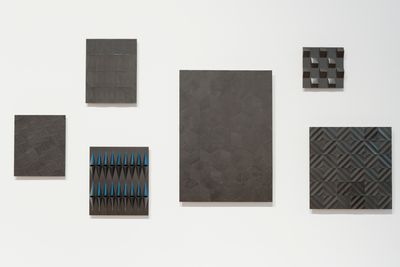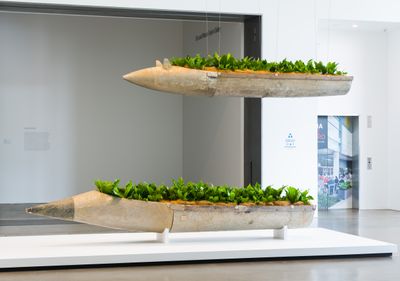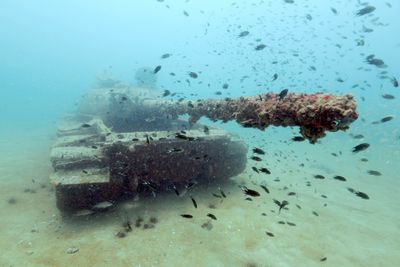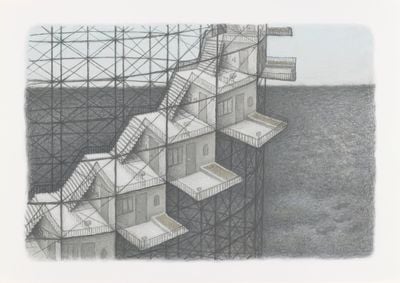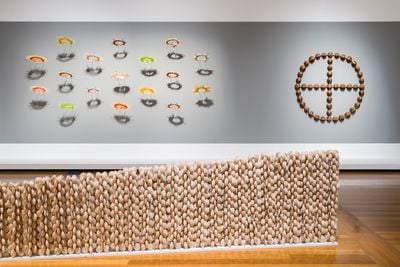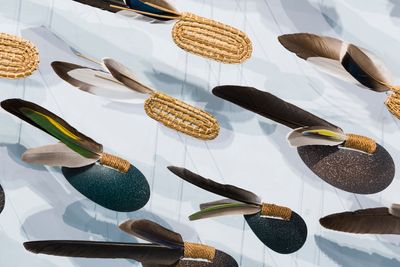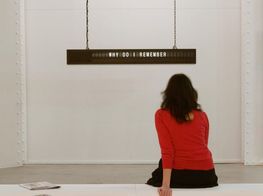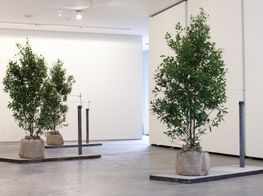The 9th Asia Pacific Triennial Keeps Up With The Zeitgeist
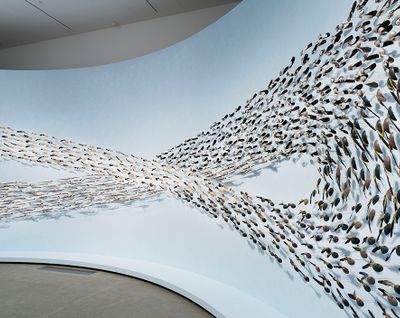
Jonathan Jones and Wiradjuri/Kamilaroi peoples with Dr Uncle Stan Grant Snr AM Wiradjuri people, (untitled) giran (2018) (detail). Mixed media. Sound design: Luke Mynott, Sonar Sound. Exhibition view: 9th Asia Pacific Triennial of Contemporary Art, Queensland Art Gallery | Gallery of Modern Art, Brisbane (24 November 2018–28 April 2019). Courtesy the artists and Queensland Art Gallery | Gallery of Modern Art. Photo: Natasha Harth.
Looking through the windows that front Indonesian artist Aditya Novali's wall installation The Wall: Asian (Un)Real Estate Project (2011), a series of miniature apartments come into view: private interiors that are sometimes bland, strange or garish (Hello Kitty decor characterises one space, for example, while multiple Duchamp-like toilets appear in another).
The work, on view as part of the 9th Asia Pacific Triennial of Contemporary Art (APT9) (24 November 2018–28 April 2019), offers the obvious but nevertheless intriguing parallel of peering into the worlds of APT9's exhibiting artists. Whether this engagement is fleeting or meaningful is an open question, and raises the issue of what viewers can and should expect from a contemporary art exhibition like this one.
The APT, organised and staged at Queensland Art Gallery | Gallery of Modern Art in Brisbane (QAGOMA), is now in its 25th year. This 2018 iteration showcases some 400 works by more than 80 artists from over 30 countries, with the show's numbers keeping up with the zeitgeist. Female artists are in the majority, with strong works throughout, including Aisha Khalid's Water has never feared the fire (2018): three large ceiling-to-floor hanging embroidered banners made from stitching and applied steel and gold-plated pins, rich in a palette of gold and blue, and depicting the Chabargh (Urdu for the 'four gardens' referenced in the Qur'an).
Shilpa Gupta's For, in your tongue, I cannot fit (2017–2018) is a powerful immersive, multi-channel sound installation that is grand in its redress of historical wrongs. Via 100 overhanging old-fashioned microphones, the audience hears the voices of 100 international poets and writers all of whom were jailed for their writings. Below each microphone, the relevant text excerpt is typed on paper and riven by a spear-headed metal post. Ayesha Sultana's paper and graphite folded drawings Vortex, Grille I, Grille II, and Grille III (all 2018) mimic the hard and shiny surface of a metallic object, confusing the eye.
A quick flick through previous catalogues in QAGOMA's library illustrates how far this triennial has come from its debut—the contemporary art world in 2018 is unrecognisable from that of 1993, especially in the Asia-Pacific context. Twenty-five years ago, countries such as China were just emerging on the international art scene, while many of the countries whose artists now participate in the Triennial were producing little contemporary art and had limited access to education, galleries, and the necessary infrastructure that is now more frequently available.
In the context of contemporary art, APT9 reflects the ever-expanding map of the Asia-Pacific region, now encompassing the Middle East and Asia Minor and stretching across half the surface of the globe. This has resulted in a shift in the idea of a shared geography that once tethered previous editions, with APT9 also marking the first-time participation of artists from Laos, and the largest ever number for Bangladeshi artists.
There are common themes, links, and stories: ideas around migration, land ownership, environmental degradation, climate change, cultural appropriation, colonisation, censorship, and war. But rather than offer a bridge to common understanding or experience, the prevalence of these topics illustrates and reinforces how such issues now occupy so much of the world's population that they have become generically global.
The sea is one motif that seems to offer a common ground and a place to reflect: a pathway from one position and one view to another. Monira Al Qadiri from Senagal/Kuwait shows her four-screen video work DIVER (2018), which links the culture, traditions, and history of pearling in the Gulf alongside that of the oil industry (both wealth industries and both now in decline) via images of women swimming in synchronised routines in pearlescent waters that could also represent an oil slick.
Martha Atienza's Our Islands 11°16'58.4"N 123°45'07.0"E (2017) shows a procession of fully dressed, variously costumed figures gliding and striding under the waters off Bantayan Island in the Philippines, in a re-creation of the Ati-Atihan festival staged in the artist's hometown of Madridejos.
Of course, the ocean is not neutral ground; it often acts as a border that separates countries from each other. In this sense, it is at once a contested territory in a fractious, discordant world, and a force of its own.
Thai artist Tada Hengsapkul's You lead me down, to the ocean (2018), for example, shows a sunken Thai military tank covered in barnacles and its gun barrel crusted over, which now serves as a dive site for tourists and a shelter for marine creatures—a relic with life swirling around it. These works reinforce the effects of geographical fragmentation at a time when national borders are being strengthened, with the artists looking for meaning in their own culture's traditions and histories.
Where things break apart, artists find space to investigate and comment on the status quo. In the case of Korean artist Kim Beom, two inkjet prints resembling architectural drawings from his 'Blueprints and Perspectives' series (2002–ongoing) approach reality as something that can be absurd, and even sinister. Schematic Draft of a Disconnected Under River Tunnel (2017) and Residential Watchtower Complex for Security Guards (2017) present renderings for what is described in each work's title, with each 'plan' accompanied by a blueprint showing the internal layout of the construction described.
On closer inspection, these proposed projects are nonsensical: the underwater tunnel doesn't lead anywhere and the idea of security guards living in a watchtower complex where they might keep an eye on each other is satisfyingly bizarre. In creating schematics for structures that are impractical, the artist explores the gap between the imaginative, personal realm and that of the 'real' world; and while the viewer is left with the feeling that these proposed buildings are ridiculous, there is the sense that they might exist.
The realm of the imagination and the re-imagining of existing frameworks also emerged during a talk with artists Naiza Khan and Munem Wasif, staged during APT9's opening weekend. In their discussion, Khan and Wasif touched on the idea of walking through landscapes and the role of the body—something that came through in Wasif's APT9 contribution, the magic realist film Kheyal (2015–2018). Kheyal follows four characters as they go about their daily activities in Old Dhaka, their stories intersecting to reveal the intriguing environments and atmosphere of the historic city. Wasif notes that people in Dhaka believe in the existence of a parallel reality, and the film reinforces this idea with shifting time frames that support the idea of time travel.
But while Kheyal explores the potential of the imagination to emancipate the body in the physical realm, Khan's series of metal sculptures made from steel, feathers, and leather seem designed to do the opposite. Works such as her Armour Suit for Rani of Jhansi II (2017) resemble both medieval armour as well as items made to restrict the female body, such as corsets and chastity belts. The work's defiance recalls Mithu Sen's UnMYthU: UnKIND(s) Alternatives (2018)—lushly coloured drawings of human bodies hung on the wall in lightboxes accompanied by codified interventions around language and sexuality, including a contract that seeks to undo hierarchies.
Roughly a third of the exhibition is devoted to artists from the Pacific, which includes countries as diverse as New Zealand, i-Kiribati, Papua New Guinea, and Tonga. Many artists who live in this disparate region also embrace the talisman of the sea and its flotsam—boats, shells, fish, coral—or relate to it as a conceptual space of imaginative possibility.
A suite of works from the 'Tungaru: The Kirabati Project' series—a collaborative venture initiated by New Zealand artist Chris Charteris with a group of artists from i-Kiribati—make the leap from artefact to contemporary artwork. Taking the original forms of traditional objects, sculptures include Te Ma (Fish trap) (2014), an installation representing an abstracted fish trap made from cleaned and polished shells; Te Tai –Te Mae Ni Maie (headdress for dancing) (2017–2018), colourful headdresses made from plants and plastic straws; and Te Buangui (The whale tooth) (2018), a wall-hung piece of armour made from dried puffer fish, coconut fibre string, and flax.
Australian Indigenous artist Jonathan Jones' sweeping, undulating wall installation (untitled) giran (2018) is also a collaborative effort: in this case, with Wiradjuri elder Dr Uncle Stan Grant Snr and members of the Wiradjuri people. A group of well-known weavers and carvers worked with the artist to weave and carve each section of this work, representing six Aboriginal tools, such as a mussel scraper and a spear point, created from materials gathered by members of the group, such as freshwater mussel shells, feathers, emu eggs, stones, kangaroo bones, and wood.
The piece references the idea of 'murun': a Wiradjuri word meaning breathe or life, and an audio installation that accompanies the piece emits the sounds of bird calls, whistling wind and whispering voices. During the media launch of the exhibition, Jones spoke about the cycles of wind moving through country and how a gust of wind is a reminder of the past. For him, the work is a way of reclaiming the history of his country and people, while renewing and strengthening community bonds through the collective act of making.
Jones' viewpoint offers a way of reading many of the works by Indigenous and First Nations artists included in the exhibition: one element that sets the APT apart in general, given the opportunity the show provides when it comes to experiencing art that is rarely seen anywhere else in the world.
Of all the outstanding works at APT9, the one-off performance staged during the opening preview by Brian Fuata and Latai Taumoepeau, Odyssey 'o Fehuluni (2018), resonates with the ethos of this edition of APT the most. Fuata, with his head painted demon-red, rolled and pushed a gratingly metallic 24-gallon drum, now on its side and fitted with a handle, as Taumoepeau walked behind, an imposing figure dressed in what appeared as a shark-mouth headdress and feathered gown. Slowly and noisily—perhaps in an interpretation of a ritual designed to scare evil spirits away—they entered the 'hallowed' contemporary gallery foyer, as if heralding the arrival of a new artistic future.
This is what audiences can expect from an exhibition like the APT: the opportunity to gain insight—and not just glimpses—into worlds that are often out of reach. Fuata and Taumoepeau's powerful intervention demonstrated how, in 2018, many of the voices that have historically been excluded from the wider conversation (inside and outside art) are not only knocking at the door, but have entered the building. —[O]


